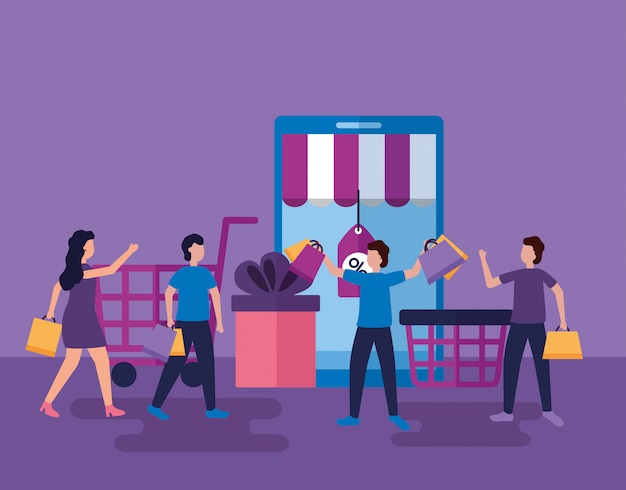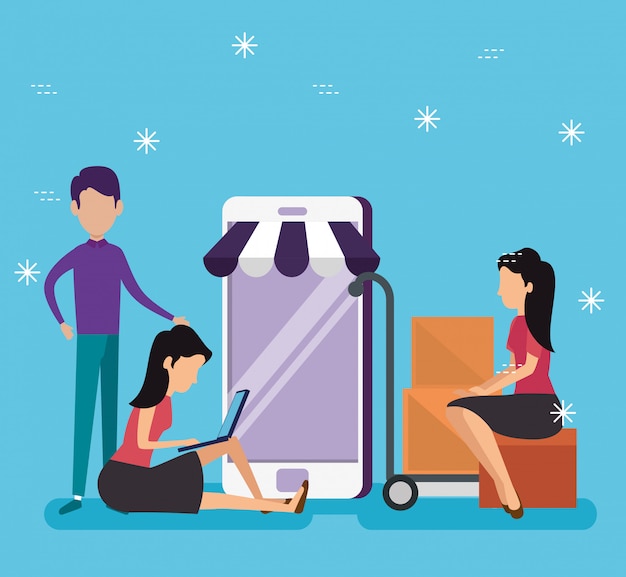Is Quick Commerce Winning over the E-commerce and Offline Consumers?

Imagine craving your favorite snack and having it delivered to your doorstep before the thought even finishes crossing your mind. Welcome to the era of instant gratification, where speed and convenience reign supreme. Over the years, consumer preferences have evolved from traditional shopping in brick-and-mortar stores to e-commerce's promise of selection and ease. Now, quick commerce (q-commerce) is setting a new benchmark in the race to win over consumers.
Quick commerce, or q-commerce, takes convenience to the next level by offering ultra-fast delivery—often within 10 to 30 minutes. This model relies on strategically located local hubs, advanced logistics, and cutting-edge technology to fulfill consumers’ ever-growing expectations.
But how does q-commerce stack up against the familiar giants of e-commerce and offline shopping? Let’s delve deeper into this fast-evolving retail revolution.

Embrace the future of shopping with q-commerce—swift, seamless, instant!
Is Quick Commerce Winning Over E-Commerce and Offline Consumers?
Q-commerce is transforming the landscape of consumer purchasing habits by offering unparalleled speed and convenience. By focusing on smaller basket sizes, hyperlocal operations, and ultra-fast delivery, Q-commerce is carving out a distinct market niche. Here’s a detailed breakdown of what differentiates Q-commerce from traditional e-commerce and offline shopping models.
- Speed: The defining feature of q-commerce is its ability to deliver products almost instantly. In an era where time is considered the ultimate luxury, this speed differentiates it from traditional e-commerce players that often take hours or days to deliver.
- Convenience: Q-commerce eliminates the friction of traditional shopping—no long queues in offline stores or days of waiting for e-commerce orders. With a few taps on an app, consumers can access an array of products tailored to their needs.
- Accessibility: Operating 24/7, Q-commerce ensures that essential items are always within reach. This round-the-clock availability is especially critical for urban consumers who may require products outside regular business hours, such as late-night snacks or emergency supplies.
- Hyperlocal Operations: Q-commerce's hyperlocal model utilizes a network of strategically placed micro-warehouses or dark stores. These hubs are stocked with high-demand items, enabling shorter delivery routes and reduced transportation costs. It also allows q-commerce to adapt inventory based on regional preferences, ensuring better availability of the most relevant products.
- Customer-Centric Convenience: Q-commerce thrives on catering to smaller, more frequent purchases. This is ideal for customers who prefer to shop on the go or address immediate needs. This model contrasts sharply with traditional e-commerce, which often incentivizes bulk buying through discounts or free shipping thresholds.
- The Instant Gratification Culture: The rise of Q-commerce is deeply aligned with the instant gratification culture that defines modern consumer behavior. People value immediacy and q-commerce taps into this demand.

Q-commerce: Experience instant gratification with ultra-fast delivery!
E-commerce Consumers Shifting to Q-Commerce
E-commerce, once hailed as the epitome of convenience, is facing stiff competition from q-commerce platforms. Here's why:
- Delayed Delivery Times: While traditional e-commerce platforms like Amazon or Flipkart have improved logistics, the standard delivery windows of 1-3 days are losing their appeal. Consumers are no longer satisfied with waiting, particularly for essential or last-minute needs.
- Higher Shipping Fees: E-commerce often introduces minimum purchase thresholds or hefty delivery charges for expedited services. This contrasts with q-commerce, where the nominal convenience fees feel justified due to ultra-fast service.
- The Allure of Speed: Modern consumers value time more than ever. The immediacy offered by q-commerce isn’t just about receiving products; it’s a lifestyle upgrade. Platforms like Swiggy Instamart make it possible to order groceries during a busy workday without disrupting the schedule.
Offline Consumers Converting to Q-Commerce
While e-commerce sees a significant transition, the offline shopping audience is also migrating to q-commerce. Here's how and why:
- Convenience vs. Traditional Shopping Experience: Offline shopping has long been favored for its tactile experience and the ability to inspect products. However, q-commerce is converting even the most traditional shoppers by eliminating common pain points like commuting, waiting in queues, or hauling heavy shopping bags.
- Post-Pandemic Behavior Shift: The pandemic reshaped consumer priorities, pushing even skeptical buyers towards digital-first solutions. What started as a necessity during lockdowns has evolved into a preferred mode of shopping for many.
- Seamless User Experiences: Q-commerce platforms have mastered the art of personalization and intuitive app interfaces. By anticipating customer needs and offering curated product selections, these platforms provide an effortless shopping journey.

The Challenges of Quick Commerce
Q-commerce is redefining customer expectations with ultra-fast delivery promises, often under 30 minutes. While it’s a lucrative space, businesses operating in this model face a myriad of challenges:
Operational Challenges
Operating a q-commerce model requires overcoming significant logistical and inventory hurdles.
- High Operational Costs
- The backbone of q-commerce lies in the ability to fulfill orders in near-real-time. This involves maintaining local micro-fulfillment centers stocked with popular items, as well as investing in efficient logistics systems.
- Unlike traditional e-commerce, which benefits from centralized warehouses and economies of scale, q-commerce demands distributed inventory and a dense network of delivery personnel. In markets where margins are already slim, these costs can quickly erode profitability.
- Limited Product Variety
- Unlike e-commerce platforms that offer an expansive catalog, q-commerce is constrained by the storage capacity of micro-fulfillment hubs.
- Products are often limited to essentials, such as groceries, snacks, or household basics. This narrower selection can be a deterrent for consumers looking for a one-stop solution.
Sustainability Concerns
Q-commerce has drawn criticism for its environmental and social impact.
- Environmental Impact
- The push for rapid delivery often leads to frequent, small-sized deliveries, which are less efficient than bulk transportation used in traditional e-commerce.
- Increased vehicle usage for these deliveries contributes to higher carbon emissions. Packaging waste is another critical issue.
- Strain on the Workforce
- Q-commerce places immense pressure on workers, who are often underpaid and lack access to essential benefits like health insurance or job security.
- High turnover rates and worker dissatisfaction pose long-term risks to the sustainability of this labor-intensive model.

Embrace the q-Commerce wave – Shop smarter today!
Who Is Driving Q-Commerce Adoption?
The rapid adoption of q-commerce is being driven by several key groups, each playing a pivotal role in shaping the landscape of this ultra-fast delivery ecosystem:
- Urban Millennials and Gen Z: Urbanization and the digital-native status of millennials and Gen Z make them the prime audience for q-commerce. These groups value the immediacy and digital-first approach that q-commerce offers. Millennials often manage careers and families; and seek solutions that maximize efficiency. Gen Z, known for their reliance on smartphones, has high expectations for seamless and speedy services.
- Key Demographics at a Glance: Q-commerce thrives in dense urban areas where short delivery distances enhance feasibility. High smartphone penetration and comfort with apps are prerequisites for adoption. Additionally, consumers with fast-paced lives find q-commerce invaluable for last-minute needs.

Fueling convenience with q-commerce —join the revolution today!
Retention Strategies: Q-Commerce vs. Traditional Players
Q-commerce platforms leverage innovative strategies to build customer loyalty, setting themselves apart from the approaches used by traditional e-commerce giants and brick-and-mortar retailers.
- Subscription Models: Many q-commerce providers offer subscription-based services with perks such as free deliveries or priority access during peak hours. This approach mirrors the success of e-commerce subscription programs like Amazon Prime but with an added focus on immediacy.
- Hyper-Personalization: Using AI and data analytics, q-commerce platforms tailor user experiences to individual preferences. Personalized product recommendations, targeted discounts, and reminders based on order history create a "sticky" customer relationship.
- Community Integration: To compete with the local appeal of offline retailers, q-commerce brands are emphasizing hyper-local inventory. This ensures customers get what they need, faster—and often fresher.
While q-commerce has the spotlight, traditional players are not sitting idle. Brick-and-mortar stores leverage their physical presence for buy-online-pickup-in-store (BOPIS) strategies, while e-commerce giants continue to optimize delivery logistics. However, the gap in immediacy remains significant.

The Verdict: Is Q-Commerce Really Winning?
Q-commerce is growing rapidly but remains a niche player when compared to its older siblings—e-commerce and offline retail. Recent statistics reveal that q-commerce accounts for 2–5% of the global retail market, while e-commerce commands a hefty 20–25% share, and offline retail continues to dominate at nearly 70–75%. Its growth trajectory, however, is steep - expected to grow at a CAGR of 20–25% over the next five years.
Q-commerce thrives in dense, urban areas where the population density and infrastructure support its model. Cities like Delhi have seen Q-commerce companies like Blinkit flourish due to the critical mass of tech-savvy consumers willing to pay for convenience. However, scaling this success to rural or low-density regions is a major challenge due to high operational costs in these areas, with sparse populations and infrastructural constraints. Additionally, q-commerce’s reliance on tightly controlled delivery zones makes it less flexible compared to the expansive reach of e-commerce giants like Amazon.
Therefore, q-commerce is unlikely to completely replace e-commerce or offline retail. Instead, its growth points towards the rise of hybrid models, which combine the best of all three worlds:
- E-commerce for Range: Offering a vast selection of goods across geographies at competitive prices.
- Offline Retail for Experience: Providing sensory experiences, brand engagement, and instant gratification through physical stores.
- Q-commerce for Speed: Fulfilling urgent, convenience-driven needs with hyper-fast delivery.

Embrace the hybrid future of retail with Ginesys—speed, range, and experience combined!
Final Thoughts: The Future of Retail and Consumer Choice
Q-commerce has emerged as a disruptive force, carving out a pivotal role in the evolving retail landscape. While it is unlikely to replace traditional e-commerce giants or offline shopping, its convenience, speed, and consumer-cetric innovations make it a formidable player in the modern marketplace. At the core of this transformation is consumer-centric innovation—the force driving retailers to reimagine their offerings and adapt to ever-changing consumer expectations.
As we look forward to 2030, the question isn’t just about choosing between q-commerce, e-commerce, or offline shopping—it’s about how these models will converge to redefine convenience, variety, and experience. The future of retail lies in this synergy, where the boundaries blur, and innovation takes center stage. Which of these possibilities excites you most? The journey ahead promises to reshape how we shop, connect, and engage.
